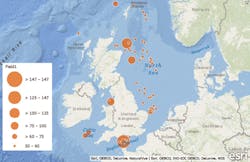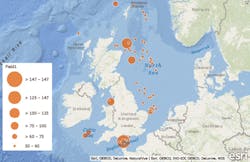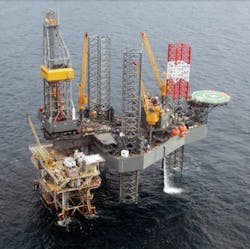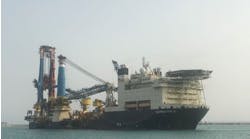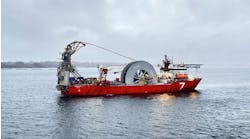Natural energy source could also enhance oil recovery
George Lockett
North Sea Geothermal Power Project
Traditionally, once an oil or gas field reaches the end of its productive life, its production platform is decommissioned. The structure may be removed and taken ashore for recycling/reuse, or part of the platform may remain on the seabed, perhaps creating an artificial reef. However, another alternative is becoming a more viable option – re-using the platform to extract geothermal energy. If applied to redundant platforms in the North Sea, this could create a whole new industry employing thousands of workers in new productive jobs in the offshore and onshore support sectors.
50 hottest geothermal gradient wells by degrees C. (Image courtesy CGG Geothermal Database)
Geothermal power has an enormous potential to provide affordable, clean energy that avoids emission of greenhouse gases such as carbon dioxide (CO2). Geothermal energy is true base load, producing electricity round the clock and could easily be integrated with offshore wind farms, or alternately supply power directly to rigs or platforms that may have a higher requirement due to secondary oil recovery or CO2 storage projects.
The UK continental shelf (UKCS) where many platforms are situated has a relatively thin earth’s crust – around 10 km (6.2 mi) thick compared to 40-70 km (25-43 mi) thick on land – which gives the wells their high bottomhole temperatures. There are more than 50 wells in the region with a geothermal gradient more than 122°F (50°C)/km, the highest being 296°F (147°C)/km. At Total’s Elgin-Franklin high-pressure/high-temperature (HP/HT) gas condensate development in the UK central North Sea, one of the wells was drilled to a depth of 6,100 m (20,013 ft), with a temperature of 387°F (197°C) and a pressure of 16,750 psi (1,155 bar).
Heat from these wells could be employed to generate electricity on board the platform that could in turn be routed to the UK’s national grid via subsea cables. North Sea platforms have the advantage of being surrounded by cold sea water, which is at a much lower temperature than the onshore air cooling towers that are the conventional means of condensing a generating plant’s working fluids after they have passed through the turbines.
It would also be possible to re-inject waste heat remaining in the fluids back into the subsurface oil-bearing level to increase field pressure and flows, thereby enhancing secondary oil recovery and extending field life. Furthermore, discovery of further oil fields might follow when drilling to greater depths to tap the geothermal energy beneath the platforms.
North of the UK northern North Sea, there are potential sites for geothermal energy extraction away from the continental shelf into deepwater. On the east of the UKCS, there are potential sites on the Mid Continental Ride, all the way down to Norfolk.
Elgin and Franklin are around 161 km (100 mi) east of Aberdeen, as is Shell’s yet to be developed ultra-HP/HT Jackdaw gas condensate field in block 30/2a. Jackdaw’s 17,250-psi (1,189-bar) reservoir pressure and temperatures of 385°F (196°C) at its base make it the highest-pressure field found to date on the UKCS.
In the south of England, there are sites near Southampton on the coast, one with a geothermal gradient of 297°F (147°C)/km. Southampton City has been operating a geothermal district heating system for several decades.
Global potential
Geothermal energy has huge potential when set in context against other energy reserves. All fossil fuels, i.e. coal, oil and gas, come from the earth’s crust. The crust makes up only 0.4% of the total mass of the planet, the remaining 99.6% being hotter than 932°F (500°C) within the crust, increasing to 9,032°F (5,000°C) at the core. The pressures within the earth are constantly generating this heat naturally. This means that geothermal energy is infinite in its nature, as it is naturally renewable.
There are many areas of the world where hot water/steam reservoirs (hydrothermal fields) exist naturally. These are usually associated with fault lines between continents, and volcanic areas where hot springs, geysers, and fumaroles are common. Recent research carried out in Russia, in the Kola Peninsula, has revealed moving fluids and open fractures at depths more than 12 km (7.5 mi). This discovery has led to a review of current deep geological thinking and has opened the development of geothermal energy extraction for electrical power generation.
A Super 116E (Enhanced) jackup drilling rig. (Photo courtesy Cameron/Schlumberger)
So, what are the current limits of exploration for geothermal energy, in offshore terms? One of the most advanced rigs for deep subsurface wells is the Super 116E (Enhanced) Class self-elevating mobile offshore drilling platform, designed to operate in water depths of up to 106 m (350 ft), with a rated drilling depth of 10,000 m (30,000 ft).
This is well within the range of drilling for geothermal energy purposes. At the Iceland Deep Drilling project on the country’s Reykjanes Peninsula, in which Statoil was an active participant, drilling of the IDDP-2 well was completed in January 2017 at a depth of 4,659 m (15,285 ft), with all initial targets achieved. These were to drill deep, extract drill cores, measure the temperature and search for permeability. At the base of the well the temperature was measured at 800°F (427°C), with a fluid pressure of 4,931 psi (340 bar); drill cores were retrieved, and the rocks appeared to be permeable at depth. The bottom of the well reached fluids at supercritical conditions, so the main drilling phase objective had been achieved.
As for the safety aspects of generating geothermal energy from an offshore platform, Britain’s Health and Safety Executive has published two documents to highlight the safety issues associated with renewable energy. One, issued in June 2006 and connected to the UK government’s Energy Review, stated that: “There are many sources of renewable energy. Some, such as the use of photovoltaic solar energy, geothermal energy and hydroelectricity present relatively few human health and safety risks and are already well understood and managed.”
Well-known companies in the oil and gas industry such as Baker Hughes have been involved in the safe operation of geothermal projects. To quote from the company’s HP/HT – Geothermal website: “Our Integrated Operations offers total wellbore planning, construction and management. This includes a detailed pre-well planning process to design a [customized] wellbore construction plan…”
There are three types of geothermal energy. One – Geo-pressure – is where you have a high wellhead pressure, to which you can attach a hydroelectric type turbine to generate the power or electrical power from a natural gas letdown station. The twin screw turbine design from Langson Energy produces 1 MW electrical output, operating in temperatures from 350-550°F (177-288°C) and up to pressures of 600 psi (42 bar). This is already deployed by the natural gas industry to generate power, where the gas mains changes pressure to use the power instead of it being wasted. A second is created by separating the gas from the oil/water brine and using it like a diesel-type generator, i.e. burning the gas to produce power, which could provide an alternative to flaring on certain offshore installations. The third involves using the temperature, as in the high-pressure steam, steam, Organic Rankine Cycleturbine system. This approach could be applied to platforms or on a nearby support vessel.
Geothermal for life extension
Geothermal energy could potentially extend the life of some North Sea platforms by a further 30 years through being channeled for electrical power generation, or by bringing geothermal heat from a lower level to heat offshore oil fields to help recover heavier tar oils. And if it makes economic sense to connect the UK to France by cables to use French nuclear power, then it must also make economic sense to connect these platforms to the mainland to use geothermal power.
In April 2012, the then UK energy minister Charles Hendry and the Icelandic ambassador discussed the idea of an interconnector to transport renewable energy from Iceland’s geothermal and hydro sources to UK homes. With voltage drops over long distances, it seems more logical to exploit North Sea geothermal energy than to bring geothermal power 804 km (500 mi) from Iceland. Shorter interconnectors are more practical, and to be producing the power in UK waters and selling it on to other European countries would also make commercial sense for Scotland and other parts of the UK. Furthermore, geothermal power would bring a more balanced power supply as a supplement to offshore wind by guaranteeing a 24/7 baseload figure.
Enhanced oil recovery
Another possible application for the North Sea is the use of geothermal supercritical carbon capture and storage CO2 for enhanced oil recovery. This is a continuous process that offers many advantages over other forms of enhanced or secondary oil recovery that work on a batch process, using the same well as production. This system has a long field life of up to 30 years and provides an alternative to employing water as the working fluid.
The main advantages are:
The carbon capture and storage CO2 would remain mostly in the reservoir, thus serving as a long-term storage location in the oilfield when the oil has been completely removed.
CO2 does not have a chemical reaction with the geology in the same way as water does, at high temperatures. Thus, there is less movement of salts and other contaminants from the reactivity of rocks in the formation as the fluids pass.
Secondly, the changes in density with temperature and pressure of supercritical CO2 suggest that the use of pumps for moving CO2 could be partly or completely eliminated by formation of a thermosiphon.
Not a batch process, so continuous extraction of oil is possible from the production well(s).
Disadvantages of the process are:
The need to drill two deeper wells to reach the geothermal field for the higher temperatures. However, there is plenty of evidence, in Iceland and in many other countries around the world, that the geothermal wells will continue working for many decades.
At present it is an unproven technology for enhanced oil recovery. However, there are documented examples of supercritical CO2 use in geothermal, notably: “A Hot Dry Rock Geothermal Energy Concept Utilizing Supercritical CO2 Instead of Water.”—Brown at Los Alamos National Laboratories, USA.
Use of CO2 for enhanced recovery of heavy-oil has already proven to be effective—however, supercritical CO2 may be better and more effective due to the high pressure and temperature.
Raising the temperature of the CO2 through the geothermal hot rock reservoir should help achieve the necessary miscibility with the heaver oils at higher temperatures—immiscibility being a known issue with heaver oils that have not been heated with HP/HT SCCO2 in the geothermal EOR system described above.
Oil displacement by CO2 injection relies on the behavior between CO2 and crude. This interaction depends on the oil’s weight, and the reservoir characteristics. In high-pressure applications with lighter oils, CO2 is miscible with the oil, with resultant swelling of the oil and reduction in viscosity, and possibly also a reduction in the surface tension with the reservoir rock. All these effects serve to improve the flow of oil to the production wells.
For more details regarding The North Sea Geothermal Research Project,[email protected]
